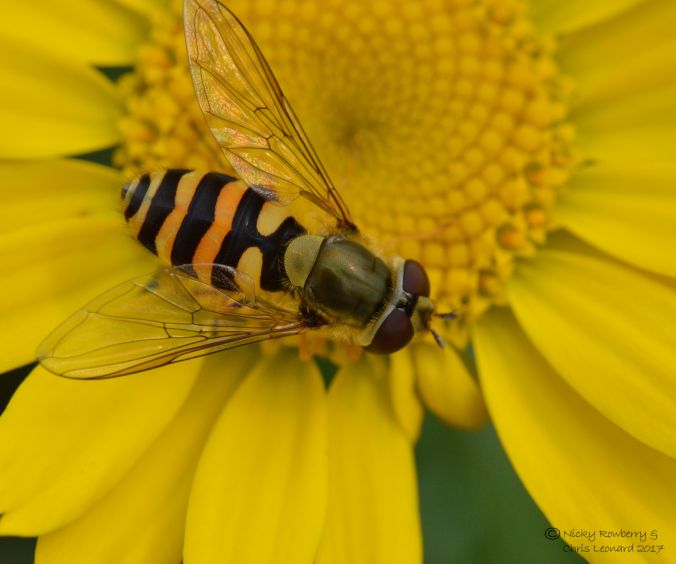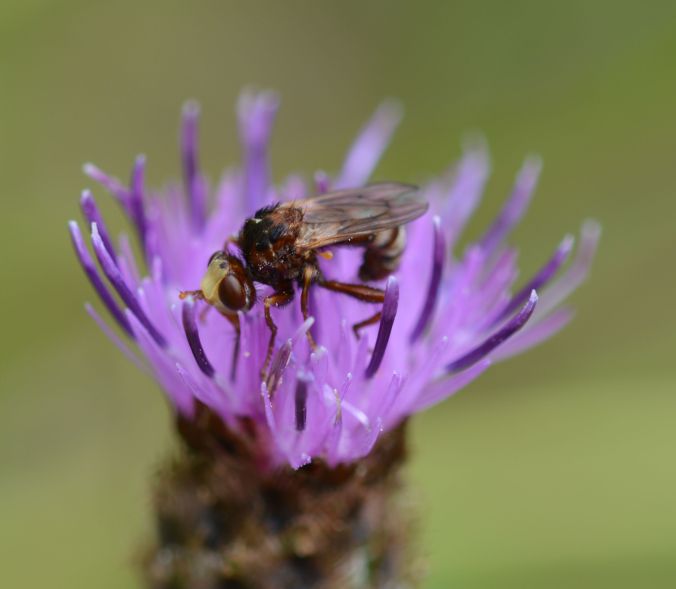It has been a mixed week for us, but one thing that is definitely doing well is the population of pollinators in our garden. I’ve been meaning to do an update on our “Plant a Pot for Pollinators” pot for a while now. I started this post yesterday morning, but it’s taken until this afternoon to finish, as I keep spotting things buzzing round the garden and dash out to take more photos!
 When I planted the pot for pollinators back in June, the plants were all small and everything was neat and tidy (the only things in our whole garden that could be described thus). Now, just a month or so later, everything has gone a little bit wild and crazy and to be honest is fitting in with the rest of the garden much better for it. The flowers are all overflowing the pot, but the main thing is that it is buzzing with life – result!
When I planted the pot for pollinators back in June, the plants were all small and everything was neat and tidy (the only things in our whole garden that could be described thus). Now, just a month or so later, everything has gone a little bit wild and crazy and to be honest is fitting in with the rest of the garden much better for it. The flowers are all overflowing the pot, but the main thing is that it is buzzing with life – result!  Being organic and unkempt our garden is generally not short of a pollinator or two, but it’s nice having a pot specifically planted with colourful flowers for them. The hoverflies in particular seem to be making good use of the pot. I am very much a beginner when it comes to hoverfly identification and there are an awful lot of species. Fortunately with a helpful guide book and the even more helpful people on the hoverfly Facebook group, I’ve managed to establish that we’ve had at least 6 species visiting the pot over the last week. No doubt there have been more and hopefully I can add to that tally eventually. But here, in no particular order, are the 6 hoverflies.
Being organic and unkempt our garden is generally not short of a pollinator or two, but it’s nice having a pot specifically planted with colourful flowers for them. The hoverflies in particular seem to be making good use of the pot. I am very much a beginner when it comes to hoverfly identification and there are an awful lot of species. Fortunately with a helpful guide book and the even more helpful people on the hoverfly Facebook group, I’ve managed to establish that we’ve had at least 6 species visiting the pot over the last week. No doubt there have been more and hopefully I can add to that tally eventually. But here, in no particular order, are the 6 hoverflies.
First up Britain’s most common hoverfly – Episyrphus balteatus aka the Marmalade Fly. The stripes on its abdomen are supposed to look like the orange shreds in marmalade!
Next up is one of the Syrphus species – difficult to get to species level without a microscope, so I’ll have to stick with the genus.
Another common one next – Eristalis tenax, one of the bumblebee mimics. Their larvae live in water and are commonly known as rat-tailed maggots.
A much smaller more subtle one next Syritta pipiens – identifiable by the swollen segment on its hind legs.
The next one is colourful but delicate one – Sphaerophoria scripta.
And finally my favourite of this set of 6 – Chrysotoxum festivum. I love the markings on this one – they are known as wasp mimics for obvious reasons.
Of course lots of other things besides hoverflies have been using the pot. I couldn’t resist a photo of this cute little juvenile shieldbug sitting pretty in the middle of the flower.
Not everything is all sweetness and light though – this crab spider may have been tiny but it was definitely lying in wait for any unsuspecting pollinator to come close enough for lunch.
The star prize for visiting my pollinator pot goes to this Common Blue butterfly. We’ve never knowingly had them in the garden before, so I was thrilled that the pot had attracted one. It didn’t hang around – hence the hastily grabbed photo, but just seeing this one insect alone makes it all worthwhile for me!
While on the subject of butterflies – it is Big Butterfly Count time of year. I’ve been doing counts both in the garden and down at the allotment, plus one at my Dad’s house. There’s still time to do a count if you haven’t already done so. Besides the one-off sighting of the Common Blue, we have also been getting Meadow Browns (in the meadow that’s supposed to be a lawn!) and Gatekeepers, plus the usual Whites, Holly Blues and the occasional Comma or Red Admiral.
Last time I checked the Big Butterfly Count website they’d received over 40,000 counts. Here’s a snapshot of their map for the Malvern area – good to see I’m not the only one who’s been counting around here.
Enthused by the pollinator pot, I went hunting round the garden for other insect attracting plants. We’ve got a fair sized patch of Knapweed which seems to have seeded itself in one corner. The bees were loving it. There were quite a few leaf-cutter bees which was great to see, but almost impossible to photograph. So I gave up and concentrated on bigger bees that were more slower and more obliging.
Aside from the usual bees, butterflies and hoverflies, I found this unusual looking insect. I had no idea even what group it belonged to, but turns out it was a Thick-headed Fly (Sicus ferrugineus). Unfortunately for our bees it parasitizes them, so not such a welcome visitor to the garden.
While stumbling around the garden chasing bees and flies, I came very close to treading on a frog. Fortunately his reflexes were quicker than mine and he hopped out of the way into our feral strawberry plot, but not before I managed to grab a photo.
 At the beginning of this post, I said it had been a mixed week for us. The good news was that Too Lazy To Weed has been shortlisted for the 30 Days Wild Blogger Awards 2017. I’ve read quite a lot of the other blogs and there are some great ones out there, so I’m really chuffed that Too Lazy was shortlisted. It’s nice to think that this means there are other people who are interested in the same things that we are. Good luck to all the other nominees – just participating in 30 Days Wild was a win-win thing, so none of us can really lose.
At the beginning of this post, I said it had been a mixed week for us. The good news was that Too Lazy To Weed has been shortlisted for the 30 Days Wild Blogger Awards 2017. I’ve read quite a lot of the other blogs and there are some great ones out there, so I’m really chuffed that Too Lazy was shortlisted. It’s nice to think that this means there are other people who are interested in the same things that we are. Good luck to all the other nominees – just participating in 30 Days Wild was a win-win thing, so none of us can really lose.
The very sad news for us this week though was that we had to say goodbye to our beautiful old boy Bertie. He was the factory cat at Chris’s work for many years, but came to live with us (his retirement home) two years ago. A great big cat with an even bigger personality and we miss him terribly. xxx

















Aww thinking of you at this sad time. Poor Bertie. Your plant pot for pollinators looks wonderful! Congrats on your blog nomination, you deserve it, your blog is so good! Good Luck! 🙂 x
LikeLiked by 1 person
Sorry to hear about your lovely cat. He obviously had a good retirement home with you.And congrats on your nomination. Well deseved.x
LikeLiked by 1 person
Thanks for your kind comments. Bertie leaves a big hole in our hearts, he was such a character. x
LikeLike
🙂 x
LikeLike
Thanks Christine. I knew you’d understand how we felt about losing Bertie, I think we are the same when it comes to our pets. So glad you enjoy the blog. I always love reading what you’ve been up to as well. Wish I was as brave as you with the wild swimming! x
LikeLike